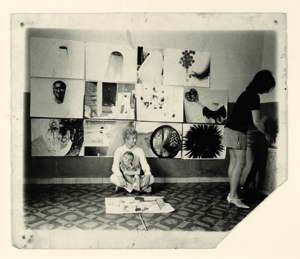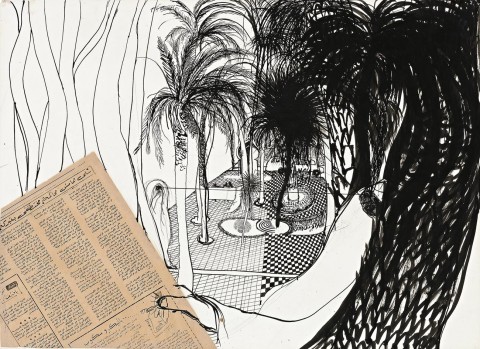TANGIER POSTCARD, 1967
BRETT WHITELEY
charcoal, gouache and collage on paper
56.5 x 76.5 cm
Marlborough New London Gallery, London
Private collection, USA
Brett Whiteley, Marlborough New London Gallery, London, 2 – 31 October 1967, cat. 4 (illus. in exhibition catalogue)
McGrath, S., Brett Whiteley, Bay Books, Sydney, 1979, p. 79 (illus.)
Sutherland, K., Brett Whiteley: A Sensual Line, 1957 – 67, Macmillan Art Publishing, Melbourne, 2010, p. 213
We are grateful to Kathie Sutherland for her assistance in cataloguing this work.
‘…Everyone’s stoned in Tangier. Very still, very gentle with an occasional really vicious fight. Water cold, sun hot, millions of things to draw and photograph. There’s some mystery still left in Morocco, but the place is dying and they’re too drugged up for the Revolution’.1
Whiteley.jpg

The Tangier Postcards in
The Majestic Hotel, Tangier, 1967
courtesy of the Whiteley Estate
With his lively personality, irreverent wit and prodigious artistic talent, it is perhaps not surprising that Brett Whiteley experienced such a meteoric rise to fame during his London expatriation in the 1960s. Although completely unknown upon his arrival in late 1960, within less than two years the brash Antipodean could boast representation in the Tate (at age 22, making him the youngest artist ever to have work acquired by the institution); the Victoria and Albert Museum; and the British Contemporary Art Collection. By 1964, his work was also held in several other national collections from Wellington to Washington. Basking in the extraordinary success and publicity generated by numerous solo shows at Marlborough Galleries, London, Whiteley soon became acutely attuned to his ‘celebrity’ status as an artist – ‘stepping up his courtship with the notion of charisma’2 in a similar vein to contemporaries such as Andy Warhol and David Hockney who elaborately crafted artistic personas to suit their painting styles. As he embraced with increasing fervor the conviction that an artist could provoke social change, towards the end of the decade Whiteley significantly shifted focus from familiar domestic themes to broader, more universal humanitarian concerns – his growing disillusionment with Western society achieving its apotheosis in his monumental magnum opus, The American Dream, 1968 –1969.
Before departing for New York at the end of 1967 to take up a Harkness Fellowship however, Whiteley ventured south with Wendy and Arkie to the French Territory of Tangier for some much-needed respite: ‘… We smoked a bit of dope, listened to music, slept, looked around. It was a good trip’.3 Although no major paintings emerged from the two months in Morocco, the sojourn proved an invaluable time of reflection and consolidation – not only offering stimulus for some of Whiteley’s most controversial works, but inspiring the charming series of eighteen gouaches and drawings which he aptly named ‘The Tangier Postcards’. Widely acclaimed among his smaller works, these casually sketched vignettes capture ‘snapshots’ of Wendy bikini-clad or nude, of their apartment at the Hotel Majestic and its exotic surroundings, as well as glimpses of the mysterious, veiled women of Tangier, and portraits of shady local characters including the hotel innkeeper, a hashish dealer and Whiteley’s new friend, the dope-smoking Achmid. As eloquently exemplified by the present postcard featuring Wendy reading the local newspaper in a wicker armchair on the balcony, many of the works exude an overwhelming lyricism, calm and sense of the exotic strongly reminiscent of Whiteley’s artistic mentor Matisse (who notably also visited Tangier in 1912 – 13). Others meanwhile are darker in tone, betraying the artist’s censure of Moroccan society which was expressed more explicitly in his notebook ‘Lying, robbing opportunists, flickering eye ruins, date-dirt-desert peasants … Moroccans … Spices that drill the tongue to the ankles, blinking tears, and all living closer than garlic, before and after, eating bean slop in cupboard cafes, hiding in bags and embalming their women, smoking their brains in and drinking and spitting and pissing mint tea under the sun – white blue white.’4 Indeed, in the end it would seem Morocco had been terrifying for Whiteley; as he wrote on a postcard to his mother, ‘Down grading of my life, my belief in man’s goodness is shrivelling. Care gets harder – God knows I’d be lost without painting.’5
Interestingly, when unveiled at Marlborough Galleries in October 1967, ‘The Tangier Postcards’ were juxtaposed alongside two powerful works dramatising Whiteley’s disturbing experience of human poverty and squalor in Calcutta; several nude drawings and paintings including Her, 1967; a couple of self-portraits, and some drawings from his time in Majorca. Almost without exception, critics condemned the exhibition for ‘a lack of cohesiveness’ – yet as the artist’s working drawing for the exhibition layout on the reverse of one of the postcards poignantly reveals, this disjunction was a deliberate ploy by Whiteley to jolt viewers out of their comfort zone, to encourage his audience to circulate between exhibits in order to draw out thematic connections and multiple readings of the issues presented. As encapsulated in typically-cryptic fashion by Whiteley in the aphorism below his layout sketch, ‘… I paint in order to Understand. I exhibit to show I don’t.’6
1. Whiteley writing in a postcard to Kay and Colin Lanceley in London, quoted in Wilson, A., Brett Whiteley: Art, Life and The Other Thing, Text Publishing, Melbourne, 2016. Spelling and punctuation errors in Whiteley’s writing have been corrected throughout.
2. Pearce, B., Brett Whiteley: Art and Life, Thames and Hudson with Art Gallery of New South Wales, Sydney, 1995, p. 28
3. Whiteley quoted in McGrath, S., Brett Whiteley, Bay Books, Sydney, 1979, p. 79
4. Whiteley, ibid., p. 80
5. Whiteley quoted in Wilson, op. cit.
6. Whiteley quoted in Sutherland, K., Brett Whiteley: A Sensual Line 1957-67, Macmillan Publishing, Melbourne, 2010, p. 183
VERONICA ANGELATOS
